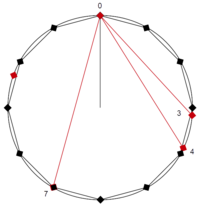
 The delta scale's approximations compared with the just values
The delta scale's approximations compared with the just values Twelve-tone equal temperament vs. just
Twelve-tone equal temperament vs. just
The δ (delta) scale is a non-octave repeating musical scale. It may be regarded as the beta scale's reciprocal, since it is "as far 'down' the (0 3 6 9) circle from α as β is 'up'". As such it would split the minor second (presumably 16:15) into eight equal parts of approximately 14 cents each Play. This would total approximately 85.7 steps per octave.
The scale step may also precisely be derived from using 50:28 (25:14, 1003.8 cents, A![]() ♯, Play) to approximate the interval 3:2⁄5:4, which equals 6:5 (E♭, 315.64 cents, Play). Thus the step is approximately 13.946 cents, and there are 86.049 steps per octave.
♯, Play) to approximate the interval 3:2⁄5:4, which equals 6:5 (E♭, 315.64 cents, Play). Thus the step is approximately 13.946 cents, and there are 86.049 steps per octave.
(Play)
The Bohlen–Pierce delta scale is based on the tritave and the 7:5:3 "wide" triad (Play) and the 9:7:5 "narrow" triad (Play) (rather than the conventional 4:5:6 triad). Notes include:
| interval name | size (steps) |
size (cents) |
just ratio | just (cents) |
error |
| minor third | 23 | 321.23 | 6:5 | 315.64 | +5.59 |
| major third | 28 | 391.06 | 5:4 | 386.31 | +4.75 |
| perfect fifth | 50 | 698.32 | 3:2 | 701.96 | −3.63 |
See also
References
- Taruskin, Richard (1996). Stravinsky and the Russian Traditions: A Biography of the Works through Mavra, p. 1394. ISBN 978-0-520-07099-8.
- "What about BP tonality?", The Bohlen-Pierce Site.
Further reading
- Bohlen, Heinz: "13 Tonstufen in der Duodezime", Acustica, vol. 39 no. 2, S. Hirzel Verlag, Stuttgart, 1978, pp. 76–86. (in German)
| Microtonal music | |||||||
|---|---|---|---|---|---|---|---|
| Composers |
|  | |||||
| Inventors | |||||||
| Tunings and scales |
| ||||||
| Concepts and techniques | |||||||
| Groups and publications | |||||||
| Compositions | |||||||
| Other topics | |||||||
| Musical tunings | |||||||
|---|---|---|---|---|---|---|---|
| Measurement | |||||||
| Just intonation | |||||||
| Temperaments |
| ||||||
| Traditional non-Western | |||||||
| Non-octave |
| ||||||
| Musical scales (list) | |||||||||||||||||||||
|---|---|---|---|---|---|---|---|---|---|---|---|---|---|---|---|---|---|---|---|---|---|
| Main Western | |||||||||||||||||||||
| Other types | |||||||||||||||||||||
| Ethnic origin | |||||||||||||||||||||
| Non-octave | |||||||||||||||||||||
| Modes |
| ||||||||||||||||||||
| Number of tones |
| ||||||||||||||||||||
This music theory article is a stub. You can help Misplaced Pages by expanding it. |
